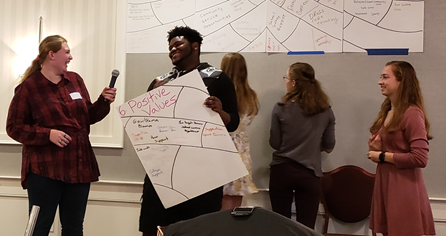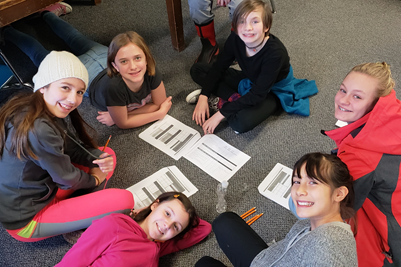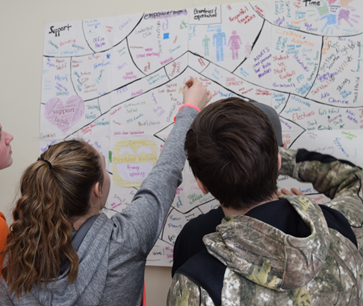Many thanks to our guest writer, Sharon Koller, who coordinates the UP for Learning‘s Getting to ‘Y’ program, which she highlights below. Although we are experiencing a moment in time that has challenged us to be innovative in the ways we continue engaging youth in our work, we know our readers are pushing forth in their efforts. Please feel free to reach out to the Adolescent and Young Adult National Resource Center (via my email, acorona@amchp.org) or directly to Sharon (email below) for assistance with thinking through how the “Getting to ‘Y'” youth engagement approach, outlined below, might be adapted for a virtual setting. Happy reading!
” [T]his generation is, and has to be, so concerned with exactly what is happening with our future.” – Alex Smart, high school junior

By Sharon Koller, Coordinator, Getting to ‘Y’
Young people care deeply about the world around them and crave meaningful opportunities to share their insights, wisdom and passion and to improve things now and for the future. Through over a decade of involvement with Getting to ‘Y’: Youth Bring Meaning to their Youth Risk Behavior Survey (GTY), I have seen such opportunities flourish as adolescents use validated local data to set priorities, engage peers and adults in dialogue about what matters to them, and take action to improve youth health and well-being.
Getting to ‘Y’ began in 2008 as a partnership between the non-profit organization UP for Learning and the Vermont Agency of Education. The Vermont Department of Health (VDH) became a primary GTY partner in 2013 and continues to see GTY as an important tool in elevating youth voice and connection as part of Maternal and Child Health Title V and Alcohol and Drug Abuse Division prevention work. Dr. Breena Holmes, MCH Director for Vermont, says, “GTY is the strength-based approach to youth voice and agency that public health needs. It is the foundation of our prevention efforts and changes the conversation in communities in meaningful ways.” To date, 147 teams from 80 Vermont schools (45%) have participated in GTY, as have 8 teams in 4 public schools in New Mexico.
GTY uses a positive youth development and action-research model where students utilize existing data (local Youth Risk Behavior Survey surveillance data) to take the lead in making sense of their own health information. The process is simple, but effective: (1) a core youth team and their adult advisor attend a youth-led training to learn and practice tools and skills to implement GTY, (2) the core team recruits a larger representative group of peers and leads them through asset-mapping, data analysis, root cause review and initial solution brainstorming, (3) the core team shares their work and leads community dialogue about their findings and ideas, (4) the core team plans and implements actions based on all they have learned throughout the process.

Before becoming the GTY Coordinator at UP for Learning, I advised GTY teams for 9 years at the high school where I worked as a Student Assistance Program counselor. Over and over, I saw the profound impact of GTY on individual and systemic levels. As expected, there were concrete changes that came about as a direct result of the students’ work: more accessible condom distribution, a peer-mentoring program, student-led consent training in health classes, and distracted driving education campaigns. Other changes were spurred by school staff and community members hearing the passionate voices of youth at community dialogues. Our school implemented suicide prevention programs in all health classes after the GTY group repeatedly focused on the data around suicide as a top concern.
Even more powerful for me to witness was the impact on individuals. Because GTY addresses issues personally relevant to all youth, and because all youth are experts in their own lived experience, our group drew in students who had leadership roles in the school as well as many students who had never joined a club or led a group of peers and adults. Because the initiative utilizes a strengths-based and structured approach which builds on scaffolded skills and experiences, the diverse groups worked well together and individuals discovered or grew their sense of themselves as capable agents of change. I never tired of hearing the confident voice of a previously “invisible” student leading a group of peers, administrators, parents, community members, and even legislators through a discussion of a sensitive and important health topic.
My anecdotal observations have been upheld by data as well. During the 2018-2019 GTY year, UP for Learning worked with the University of New Mexico Prevention Research Center, with support from VDH, to complete a mixed-methods evaluation of GTY’s impact on participants. Pre- and post-survey data of core team and data analysis participants showed significant positive changes in Health Literacy, Self-Efficacy, Community Engagement, Resilience and Protective Factors, and Knowledge, and focus groups. Written feedback pointed to increases in a Sense of Connection, Knowledge and Self-Confidence. Youth noted things like:
“I gained knowledge that I can use to help others around me if they are having a hard time.”
“I gained information about the problems and strengths about my community and state.”
“I gained a more confident voice and I learned to speak up about my opinion.”
“I had more of an opportunity to lead others in the right direction when solving youth risk problems.”
“I gotta stay involved ’cause this is the way to help the community.”
“I gained friendship and I’ve learned that I can trust people, and I don’t really trust people much. Before this I only trusted 3 people. Now I trust like 10 people.”
Getting to ‘Y’ is well-poised for replication by other states interested in engaging youth in meaningful work around their own health and well-being. UP for Learning is excited to envision a time when youth across the nation are seen as integral partners in utilizing the YRBS as a springboard for change. Who better than youth to bring meaning to their own health data and then experience the satisfaction of making the world a better place?
Information available on the GTY website or from Sharon Koller: sharon@upforlearning.org

